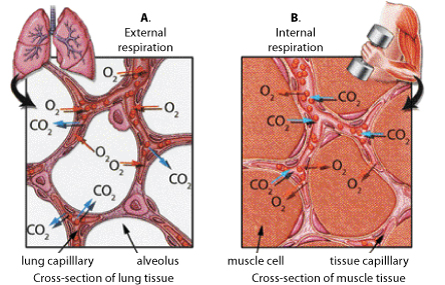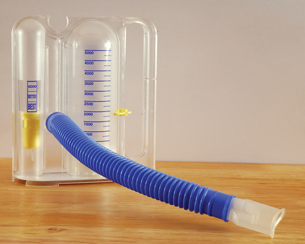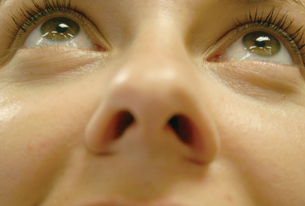Module 7 Intro
1. Module 7 Intro
1.19. Page 3
Module 7—The Digestive and Respiratory Systems
Gas Exchange

Inquiry into Biology (Whitby, ON: McGraw-Hill Ryerson, 2007), 252, fig. 7.7. Reproduced by permission.
Gas exchange occurs as a result of a difference in the partial pressures of oxygen and carbon dioxide in different body regions.
External respiration occurs at the lungs. Oxygen concentration (or partial pressure) is higher in the alveoli than it is in the blood of capillaries that surround the alveoli. As a result, oxygen moves from the alveoli to the blood. Conversely, carbon dioxide moves from blood to the alveoli because its partial pressure is higher in blood.
 Read
Read
Internal respiration involves the exchange of gases at the body tissue’s cells. The concentrations of oxygen in the blood are higher than they are in the tissue’s cells. Carbon dioxide concentrations are higher in the cells than they are in the blood. Consequently, gas exchange follows the normal patterns of diffusion—movement is from a higher concentration to a region of lower concentration. If you feel you need to further clarify this concept, read “Gas Exchange and External Respiration” starting on page 250 of the textbook.
 Watch and Listen
Watch and Listen
Watch the animation Gas Exchange that shows both external and internal respiration. Notice how the gases move from higher partial pressures to lower partial pressures. Click on the link, and then start the animation by clicking on the “Play” button. Once you have finished watching, answer the five review questions that follow.

© Glenda M. Powers/shutterstock
 Try This
Try This
TR 3. Investigation 7.A or Interpreting a Spirograph
Spirometers are given to people who have undergone heart or lung surgery. Doctors use incentive spirometers to encourage patients to regain lung capacity after surgery.
If you have access to a spirometer, try “Investigation 7.A: Measuring Respiratory Volumes” on page 251 of the textbook.
If you are unable to complete Investigation 7.A, you can complete “Interpreting a Spirograph.”
Go to your Lesson 3 Assignment to complete either Investigation 7.A or Interpreting a Spirograph.
Respiratory System Provides Protection
Up to this point, the obvious priority of the respiratory system was the exchange of gases. But have you considered that another role of the respiratory system is to defend against foreign matter and heat transfer?

Consider the analogy of a fort that provides strong protection. Soldiers in the fort fight off enemies that try to enter. Parts of the respiratory tract are like soldiers. They fight to protect people from germs, dust, and pollen in the air. Where are these body “soldiers”? How do they work? The first “line-of-defence” is found in the nose.
The inside of the nose is lined with small hairs and a sticky liquid called mucus.
- The hairs filter out dust and pollen.
- The mucus traps germs (usually bacteria) as well as dust and pollen.
cilia: small, hairlike organs on the surface of some cells, particularly cells lining the upper respiratory tract
Their wavelike movements waft particles of dust and debris outward; Latin for “eyelash.”
The nose cannot keep out all harmful substances. Some substances get past the nose and enter the windpipe. Sometimes harmful substances enter the windpipe from the mouth as well. So the windpipe must continue the fight. The windpipe, like the nose, is lined with mucus. It is also lined with very tiny (microscopic) hairs called cilia. Cilia are always beating in an outward direction, like a broom that keeps sweeping toward a door leading outside. A single hair is called a cilium.
- The mucus traps many harmful substances.
- The cilia sweep harmful substances outward.

Courtesy of the U.S. National Library of Medicine/National Institutes of Health
Coughing and sneezing also help because they build strong gusts of air. This forces out many harmful items from the respiratory tract. Sometimes the body soldiers fail in their jobs and people become ill. Then people must take proper care of themselves in order to be healthy again.
Breathing also serves to dissipate heat created by cellular respiration. This is one of your body’s methods of maintaining a 37°C core temperature. If you breathe on the back of your hand, you will feel that your breath is warmer.
To illustrate this point, you will look at the chain of reactions that occur when you begin exercising. You increase the use of your muscles. They start requiring more oxygen in order to oxidize more glucose to fuel ATP production. In the meantime, carbon-dioxide production is increased.
Breathing increases to try and maintain homeostasis. As ATP is used, or metabolized, heat is released from broken phosphate bonds. Heat is transferred from cells via the circulatory system to the alveoli. Some heat dissipates into the lungs and is transferred to the external environment as a method to maintain homeostasis.